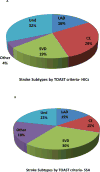Stroke, cerebrovascular diseases and vascular cognitive impairment in Africa
- PMID: 29807146
- PMCID: PMC6252289
- DOI: 10.1016/j.brainresbull.2018.05.018
Stroke, cerebrovascular diseases and vascular cognitive impairment in Africa
Abstract
With increased numbers of older people a higher burden of neurological disorders worldwide is predicted. Stroke and other cerebrovascular diseases do not necessarily present with different phenotypes in Africa but their incidence is rising in tandem with the demographic change in the population. Age remains the strongest irreversible risk factor for stroke and cognitive impairment. Modifiable factors relating to vascular disease risk, diet, lifestyle, physical activity and psychosocial status play a key role in shaping the current spate of stroke related diseases in Africa. Hypertension is the strongest modifiable risk factor for stroke but is also likely associated with co-inheritance of genetic traits among Africans. Somewhat different from high-income countries, strokes attributed to cerebral small vessel disease (SVD) are higher >30% among sub-Saharan Africans. Raised blood pressure may explain most of the incidence of SVD-related strokes but there are likely other contributing factors including dyslipidaemia and diabetes in some sectors of Africa. However, atherosclerotic and cardioembolic diseases combined also appear to be common subtypes as causes of strokes. Significant proportions of cerebrovascular diseases are ascribed to various forms of infectious disease including complications of human immunodeficiency virus. Cerebral SVD leads to several clinical manifestations including gait disturbance, autonomic dysfunction and depression. Pathological processes are characterized by arteriolosclerosis, lacunar infarcts, perivascular spaces, microinfarcts and diffuse white matter changes, which can now all be detected on neuroimaging. Except for isolated cases of cerebral autosomal dominant arteriopathy with subcortical infarcts and leukoencephalopathy or CADASIL, hereditary arteriopathies have so far not been reported in Africa. Prevalence estimates of vascular dementia (2-3%), delayed dementia after stroke (10-20%) and vascular cognitive impairment (30-40%) do not appear to be vastly different from those in other parts of the world. However, given the current demographic transition in both urban and rural settings these figures will likely rise. Wider application of neuroimaging modalities and implementation of stroke care in Africa will enable better estimates of SVD and other subtypes of stroke. Stroke survivors with SVD type pathology are likely to have low mortality and therefore portend increased incidence of dementia.
Keywords: Africa; Alzheimer’s disease; Cerebrovascular disease; Small vessel disease; Stroke; Vascular cognitive impairment.
Copyright © 2018 Elsevier Inc. All rights reserved.
Conflict of interest statement
We declare no competing interests.
Figures

References
-
- Adams HP, Jr, Bendixen BH, Kappelle LJ, Biller J, Love BB, Gordon DL, Marsh EE., 3rd Classification of subtype of acute ischemic stroke. Definitions for use in a multicenter clinical trial. TOAST. Trial of Org 10172 in Acute Stroke Treatment. Stroke. 1993;24:35–41. - PubMed
-
- Adebamowo SN, Tekola-Ayele F, Adeyemo AA, Rotimi CN. Genomics of Cardiometabolic Disorders in Sub-Saharan Africa. Public Health Genomics. 2017;20:9–26. - PubMed
-
- Ajose FO, Adelowo O, Oderinlo O. Clinical presentations of Behcet's disease among Nigerians: a 4-year prospective study. Int J Dermatol. 2015;54:889–897. - PubMed
-
- Akinyemi R, Tiwari HK, Arnett DK, Ovbiagele B, Irvin MR, Wahab K, Sarfo F, Srinivasasainagendra V, Adeoye A, Perry RT, Akpalu A, Jenkins C, Arulogun O, Gebregziabher M, Owolabi L, Obiako R, Sanya E, Komolafe M, Fawale M, Adebayo P, Osaigbovo G, Sunmonu T, Olowoyo P, Chukwuonye I, Obiabo Y, Onoja A, Akinyemi J, Ogbole G, Melikam S, Saulson R, Owolabi M S. Investigators. APOL1, CDKN2A/CDKN2B, and HDAC9 polymorphisms and small vessel ischemic stroke. Acta Neurol Scand. 2018;137:133–141. - PMC - PubMed
Publication types
MeSH terms
Grants and funding
LinkOut - more resources
Full Text Sources
Other Literature Sources
Medical

